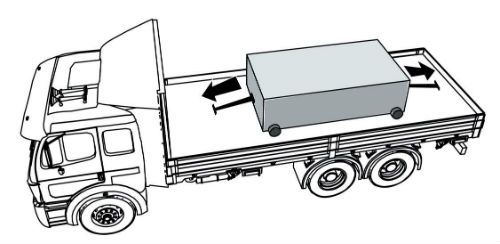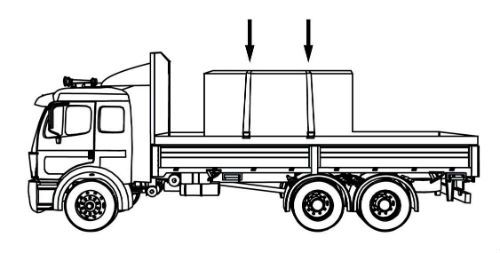CDL Practice Tests: Flatbed Cargo Securement
Choose A Section:
Go!What is the minimum WLL required of tiedowns securing loaded intermodal containers on non-chassis vehicles?
- 80% of the loaded weight of the container.
- 50% of the loaded weight of the container.
- 20% of the loaded weight of the container.
- It depends on the length of the container.
Secure each container to the vehicle by:
- Either chains, wire ropes, or integral devices that are fixed to all lower corners.
- Or crossed chains that are fixed to all upper corners.
- Or both.
Secure the front and rear of the loaded container independently.
Secure the four corners using tiedowns that are attached to the loaded container.
The tiedowns must have an aggregate working load limit of at least 50% of the loaded weight of the loaded container.
Attach each chain, wire rope, or integral locking device to the container in a manner that prevents it from becoming unfastened while in transit.
When securing an intermodal container on a chassis, what is the maximum allowable vertical travel when secured?
- 2 inches
- 2 1/2 inches
- 1/2 inch
- 1 inch
Securing devices must restrain the container from moving more than:
- 1.27 cm (1/2 in) forward.
- 1.27 cm (1/2 in) rearward.
- 1.27 cm (1/2 in) to the right.
- 1.27 cm (1/2 in) to the left.
- 2.54 cm (1 in) vertically.
To satisfy general cargo securement requirements, what is the minimum WLL for securing vehicles under 10,000 lbs?
- 30% of the weight of the cargo.
- 10,000 lbs.
- 4,500 lbs.
- 50% of the weight of the cargo.
Note: More tiedowns may be required to satisfy the general cargo securement requirements. The Standard states: "The sum of the working load limits from all tiedowns must be at least 50% of the weight of the cargo."
The load carrying area of a truck, trailer, or intermodal container is referred to as the:
- Well
- Headboard
- Deck
- Bulkhead
Deck:
The load carrying area of a truck, trailer, or intermodal container.
When securing heavy vehicles, what is the minimum WLL of each tiedown?
- 5,000 lbs
- 10,000 lbs
- 2,268 lbs
- 50% of the weight of the cargo
- Restrain cargo using a minimum of four tiedowns, each having a WLL of at least 2,268 kg (5,000 lb.).
In what circumstance can shortwood be treated as longwood?
- When it is embedded in a stack of longwood.
- Right after it is cut down.
- When it is stacked long-ways on the trailer.
- When it is painted green on the ends.
What's in a stack?

Some stacks may be made up of both shortwood and longwood. Any stack that includes shortwood must follow the shortwood securement requirements.
Exception: If shortwood is embedded in load of longwood, it can be treated as longwood.
When securing paper rolls with eyes vertical in a sided vehicle all of the following are acceptable except:
- Placing the rolls against other cargo.
- Placing rolls against the front and walls of the vehicle.
- Placing the rolls against each other.
- Placing rolls against the doors.
- Place paper rolls together in a group so that the structure of the group can be maintained.
- Place paper rolls against:
- The front and walls of the vehicle
- Each other
- Other cargo
When securing metal coils with eyes vertical, the angle between tiedown and deck, if possible, should be:
- 60 degrees
- Less than 45 degrees
- Between 60 and 90 degrees
- 180 degrees
- Attach at least one tiedown against front of row of coils to restrain against forward motion. If possible, angle between tiedown and deck should be less than 45, when viewed from the side of the vehicle.
- Attach at least one tiedown against rear of row of coils to restrain against rearward motion. If possible, angle between tiedown and deck should be less than 45, when viewed from the side of the vehicle.
- Attach at least one tiedown over top of each coil or side-by-side row of coils to restrain against vertical motion. Tiedowns going over top of coil(s) must be as close as possible to eye of coil.
- Arrange tiedowns, blocking, or bracing to prevent shifting or tipping in all directions.
A tiedown is defined as:
- A structure, device, or another substantial article placed against or around an article to prevent horizontal movement of the article.
- A combination of securing devices which form an assembly that attaches cargo to, or restrains cargo on, a vehicle or trailer, and is attached to anchor point(s).
- A strip of material that may be used to unitize articles and is tensioned and clamped or crimped back upon itself. (same as "Strapping")
- A rail along the side of a vehicle that protects the side of the vehicle from impacts.
Tiedown:
A combination of securing devices which form an assembly that attaches cargo to, or restrains cargo on, a vehicle or trailer, and is attached to anchor point(s).
When securing concrete pipe up to 45 inches loaded crosswise, tiedowns through the pipe must be:
- Nylon rope.
- Chains
- Wire.
- Straps.
Tiedown requirements
- Pipe may be secured individually or as a group.
- Tiedowns through the pipe must be chains.
- Front-to-back tiedowns may be chain or wire rope.
About The Flatbed Cargo Securement CDL Manual
Studying the flatbed cargo securement CDL manual is not a requirement for getting your CDL permit or license. It is required knowledge for flatbed drivers.
Some questions you should be able to answer for flatbed cargo securement:
- What is the minimum Working Load Limit of a tiedown used to secure logs?
- What is the minimum weight of a shipment of paper rolls that would require specific securement requirements?
- When securing concrete pipe over 45 inches loaded crosswise, which direction must the tiedowns on the front half of the load run?
- What is a cab shield?
- When securing concrete pipe over 45 inches loaded crosswise, which direction must the tiedowns on the rear half of the load run?
- What is a dunnage bag?
- Who is responsible for inspecting securing devices and cargo within the first 50 miles?
- How many tiedowns are required on a stack of shortwood loaded crosswise?
- What is the minimum working load limit of each tiedown used to secure crushed or flattened vehicles?
- Define 'bolster'
- What is a hook-lift container?
- When a tiedown is attached directly to the cargo, what is the ideal angle where it attached to the vehicle?
What is a securing device?
Any device specifically manufactured to attach or secure cargo to a vehicle or trailer:
- Synthetic Webbing
- Chain
- Wire rope
- Manila rope
- Synthetic rope
- Steel strapping
- Clamps and latches
- Blocking
- Front-end structure
- Grab hooks
- Binders
- Shackles
- Winches
- Stake pockets
- D-rings
- Webbing ratchet
- Bracing
- Friction mat
What is a tiedown?
A combination of securing devices that forms an assembly that:
- Attaches cargo to, or restrains cargo on a vehicle.
- Is attached to anchor point(s).

Some tiedowns are attached to the cargo and provide direct resistance to restrain the cargo from movement.

Some tie-downs pass over or through the cargo. They create a downward force that increases the effect of friction between the cargo and the deck. This friction restrains the cargo.
 Related Cargo Securement Terms That Every Driver Should Know:
Related Cargo Securement Terms That Every Driver Should Know:
-
Tiedown:
A combination of securing devices which form an assembly that attaches cargo to, or restrains cargo on, a vehicle or trailer, and is attached to anchor point(s).
-
Contained:
Cargo is contained if it fills a sided vehicle, and every article is in contact with or sufficiently close to a wall or other articles so that it cannot shift or tip if those other articles are also unable to shift or tip.
-
Blocking:
A structure, device, or another substantial article placed against or around an article to prevent horizontal movement of the article.
How should tiedowns be attached?
Tiedowns can be used in two ways:
-
Attached to the cargo:
- Tiedowns attached to the vehicle and attached to the cargo.
- Tiedowns attached to the vehicle, pass through or aroundan article of cargo, and then are attached to the vehicle again.
-
Pass over the cargo:
- Tiedowns attached to the vehicle, passed over the cargo, and then attached to the vehicle again.
Tiedown placement:

Place the tiedown as close as possible to the spacer.
Position the tiedowns as symetrically as possible over the length of the article.

Position the tiedowns to preserve the integrity of the article.







 TT On Facebook
TT On Facebook